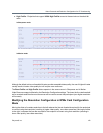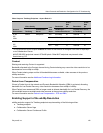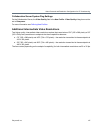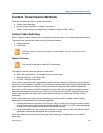
Polycom®, Inc. 128
Sharing Content During Conferences
Content such as graphics, presentations, documents, or live video can be shared with conference
participants.
Content sharing architecture is comprised of various aspects:
● Content Control Protocols - H.239 (for H.323 / ISDN), BFCP (for SIP), or People+Content
(Polycom’s protocol used for CP conferences prior to H.239 creation)
● Content Media Protocols - H.263 (AVC only), H.264 (all conferencing modes), or TIP (Cicso’s
proprietary protocol for TelePresence endpoints).
● Content Transmission Methods - Content Video Switching and Multiple Content Resolutions.
● Content Settings - Graphics, Hi-res Graphics, Live Video, or Customized Content Rate.
Content Control Protocols
Endpoints wishing to share content, request the Content Token from the MCU (in cascaded environments,
the Master MCU). The MCU uses the control protocol to grant the Content Token to the requesting endpoint
(unless in Exclusive Content Mode).
Guidelines for Controlling Content
● Only the Content Token owner may send content.
● Content Token ownership is valid until:
A new endpoint requests token ownership (unless in Exclusive Content Mode).
The owner relinquishes it.
The Content Token owner endpoint disconnects from the conference.
It is canceled by the MCU user.
Supported Content Control Protocols
Polycom supports content sharing using one of the following content control protocols:
● H.239 - For H.323 or ISDN participants
● BFCP - For SIP participants (over TCP or UDP)
● TIP Auto-Collaboration (CISCO TIP participants) - TIP Auto-Collaboration for H.264 content sharing
(see TIP Compatibility - Prefer TIP)
● People+Content - Polycom’s proprietary content control protocol; for H.323 and ISDN participants
Endpoints supporting the content control protocols above can share content within the same conference.
Endpoints without the content capabilities matching the conference content sharing
requirements, can connect to the conference but cannot share or view content in the
content channel. Depending on Legacy definitions, they can view content in the people
video layout (see Sending Content to Legacy Endpoints).


















